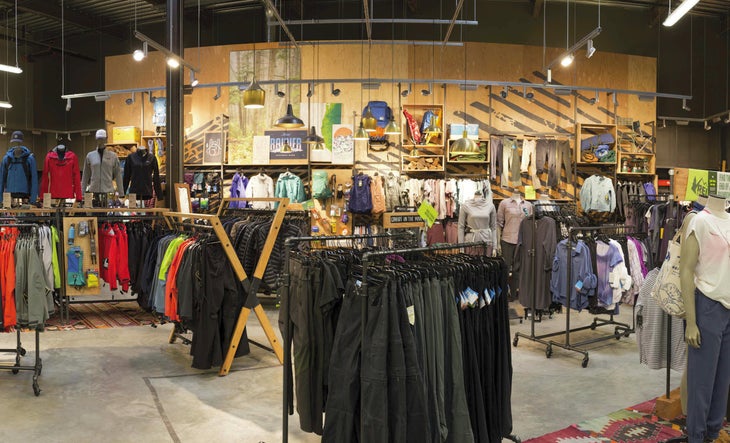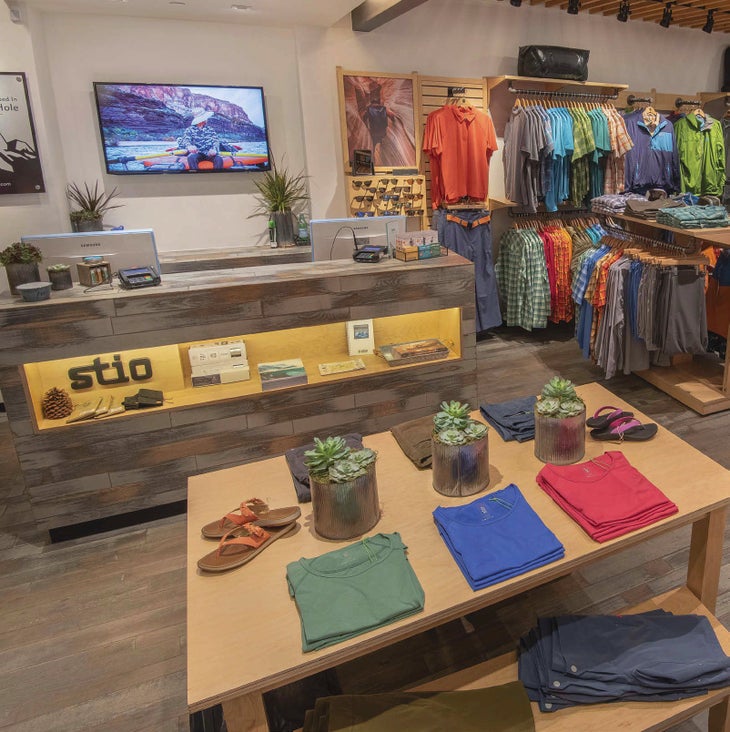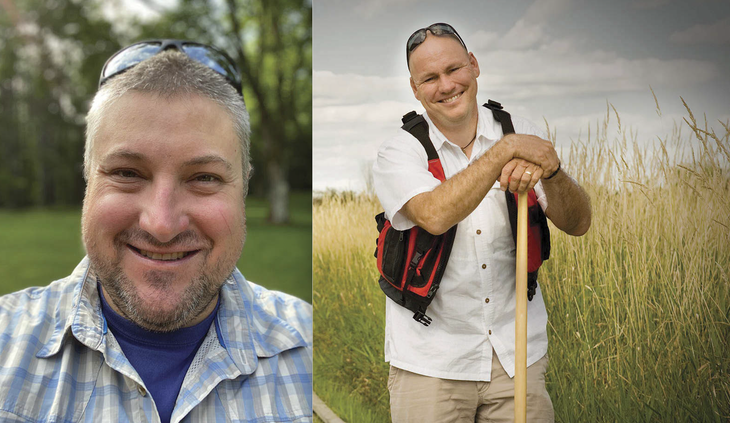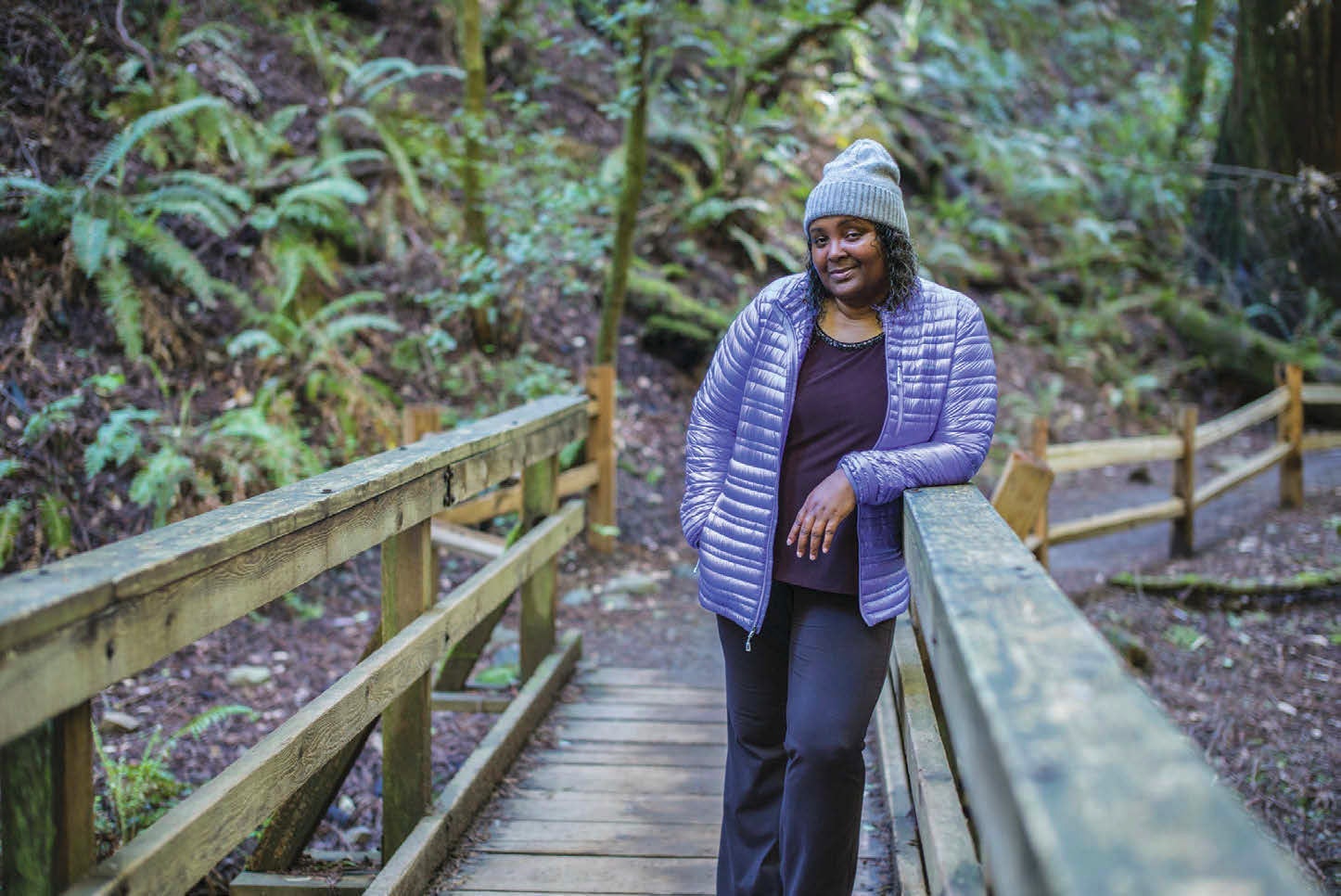Stamping Out Racism
The Outdoor CEO Diversity Pledge catalyzes business leaders to bust up the all-white club
During the summer 2018 Outdoor Retailer show, Teresa Baker roamed the aisles and asked company leaders to sign her just-launched pledge to make outdoor businesses more inclusive of people of color. More than just a statement of intent, the Outdoor CEO Diversity Pledge committed signatories to developing a bona fide action plan.
And Baker is all about action. She was far from the first person to talk about the lack of diversity in the outdoor industry. But her Pledge, and the accountability it creates among leaders, has accelerated change in a powerful way.
Initially, Baker didn’t rouse an avalanche of responses. As founder of the African American National Park Event, she wasn’t a well-known figure within the industry. But she sensed that gear brands represented a powerful way to amplify her DEI efforts beyond the national parks. After all, Baker’s hikes around Big Sur and other spots near her California home convinced her that outdoor enthusiasts already included people of color. “We hike, ski, climb—we do all these things,” said Baker. “But looking at the social media feeds of [gear] brands, you wouldn’t know that.”
So along with Chris Perkins, a Yale University forestry student, Baker developed the Outdoor CEO Diversity Pledge and its supporting program. Marmot’s general manager, Joe Flannery (who has since moved on to Callaway Golf), was among the first to sign in May 2018. A year later, the Pledge had amassed 28 CEOs who promised to craft a specific set of actions for their companies to hire and support a diverse workforce and executive leadership; present representative marketing and advertising in media; engage and support broadly representative ambassador and athlete teams; and share best (and unsuccessful) practices within the industry.
Those focus areas and the consultations with Baker’s team have helped Granite Gear take DEI “to another level,” says Rob Coughlin, general manager, who signed the Pledge in 2018. “Teresa has had such an influence on me and made me look at myself really hard,” Coughlin said. That scrutiny prompted the brand to diversify its team of trash-removing Grounds Keeper hikers, to represent BIPOC and LGBTQ+ issues on its social channels, and to emphasize diversity when hiring. Still, Coughlin knows the work is far from done. When detractors slam the company’s representation of BIPOC and LGBTQ+ hikers in its newsletters and social media feeds, “That just makes us want to do more,” said Coughlin.
Such efforts are snowballing into even greater impact. At press time, more than 220 brands had signed the Pledge and 200 more were in the pipeline. The program’s job board now lets participating organizations target and recruit diverse candidates.
The current climate has awakened Americans’ understanding that opposing racism requires active change rather than passive agreement in the status quo. But the Outdoor CEO Diversity Pledge issued that call to action more than two years ago. Its earliest adopters are showing how a real commitment to this issue can lead to real change. “People are finally understanding that the demographics in this country are shifting into a scenario where people of color are dominant,” said Baker. “We need and we demand a change.”
Green Police
REI Co-op pushes the entire industry toward a more sustainable future

How can the biggest outdoor retailer in the country be a disruptor, you ask? Its size gives it leverage, and it’s using that leverage to change the way the industry makes gear.
In spring 2018, REI unveiled a new set of sustainability standards and told its more than 1,000 vendors that they’d need to comply with everything on that list by fall 2020—or lose the opportunity to sell through REI. The five guidelines (see sidebar, below) direct companies to pursue healthier supply chains, get savvy about harmful chemicals, and incorporate sustainable materials such as organic fibers, humanely sourced down, and Bluesign-certified fabrics into their products.
These might not seem like controversial asks. After all, who would argue against the treating factory workers fairly, or avoiding the use of toxic chemicals? Yet standard manufacturing practices continue to rely on habits that harm people, animals, and the planet—because changing those norms takes tremendous effort and resources. REI has forced the issue, and brands are scrambling to comply.
Of course, not all manufacturers are behind the curve. For some, REI’s requirements merely describe practices that they’ve already put in place. But they’re the exception, not the rule. REI wanted to hasten widespread adoption, so it issued an ultimatum and set out a clear path to reach it. “Our standards are meant to help scale sustainability best practices beyond just these leading brands and to make them more achievable by every brand across our industry,” explained Greg Gausewitz, REI’s product sustainability manager.
Some standards resonate with consumers (those who prefer humanely collected down, for example). Others dictate back-end changes to supply chains, logistics, and sustainability monitoring. The requirement for brands to complete the Higg Index self-assessment tool has proven to be so difficult that REI is revising the timeline for its compliance, to be released sometime in 2020. But the disruptive effect of REI’s product sustainability standards is about more than any one requirement. It’s the sum of the parts, and the fact that brands that aren’t willing to walk the sustainability talk will lose out on the industry’s most sought-after door, potentially devastating their businesses.
The threat shocked a number of brands, says outdoor industry veteran Ammi Borenstein. As principal at Snaplinc Consulting, Borenstein has helped a half dozen brands comply with REI’s standards. “They were asking, ‘How do I get my arms around this?’ Because many of them didn’t have any basic, meaningful sustainability foundation in place,” Borenstein said.
Yet REI’s requirements also set brands on a clear path to best practices, Borenstein said: “If you’re coming from zero, it’s very hard to know what to do first, but the standards provide a starting point and roadmap.”
Even Royal Robbins, which wasn’t starting from zero, received valuable guidance from the Product Sustainability Standards. “There were a lot of things that we were working on, but the guidelines helped to sharpen our focus,” explained Kaytlin Moeller, Royal Robbins’ brand sustainability manager. As a member of the Fenix Outdoor family of brands (which includes Fjällräven and Primus), Royal Robbins had already begun to map its supply chain and had asked its tier one suppliers (which sell directly to Royal Robbins) to sign onto a sustainability code of conduct, but REI’s standards nudged Royal Robbins to extend that code of conduct to tier two suppliers (which sell to tier one).
Now, Royal Robbins is evaluating how to eliminate the practice of wrapping individual products in polybags. “It can’t happen overnight because we need to make sure our logistical system is set up to process that change,” said Moeller. Ditching polybags represents a significant change in any company’s operations, but the hope from REI is that Royal Robbins and other brands will find big strides to be more achievable once the Product Sustainability Standards lay down the stepping stones.
Of course, REI benefits from its vendors’ advances in sustainability. “Third-party brands account for the majority of REI’s product sales,” said Gausewitz. “These products also account for the most significant component of REI’s environmental footprint. So if we want to bring a more sustainable offering to our customers and continuously reduce our footprint, it’s critical that we partner with the brands we work with.” REI has dropped brands that do not align with its standards, he adds.
A crib sheet on REI’s product sustainability standards
1. Create fair and safe supply chains, using a manufacturing code of conduct that outlines social and environmental standards and pursuing Fair Trade certification wherever possible.2. Manage chemical use to avoid toxic substances, such as oxybenzone (in sunscreens) and long-chain PFAS.
3. Source materials that comply with guidelines for responsible land stewardship, such as organic crops and wood certified by the Forest Stewardship Council.
4. Ensure that animal-derived materials (such as down, wool, and leather) come from animals that received humane treatment.
5. Address products’ environmental impacts across their entire life cycle—including disposal—by completing the Higg Index Brand & Retail Module.
However, says Borenstein, some of the most exciting and far-ranging impacts of the REI guidelines have been the ways that brands are now exploring sustainability beyond those basic requirements. Fulfilling REI’s sustainability expectations has prompted a groundswell of excitement within companies that’s buoying them to greater things. “People want to do the right thing, and they want to work for a company where they know they do the right thing, so we’ve seen [REI’s guidelines] activating employee excitement,” he said. “When it becomes meaningful to brands’ customers, employees, and leadership, companies start dedicating money and time to it. That’s when sustainability takes on a life of its own.”
As with any change to the status quo, results can be somewhat hard to track, but REI remains optimistic that its efforts will address the biggest problem of our time: climate change. “We do not yet have data to show the carbon benefits of our standards,” Gausewitz said. “Addressing climate change is at the heart of our mission to fight for life outdoors, and our Product Sustainability Standards are an important tool in that fight. We continue to work to get better data so we can fine-tune our efforts and better understand our impact.”
No Strings Attached
Stio provides retailers with new gear on consignment terms

It’s one of retail’s most fundamental tenets: Shops buy goods at wholesale, sell them to consumers, then figure out what to do with the inventory that doesn’t sell. But, in 2016, Stio hatched a novel kind of consignment deal that placed new apparel “on wheels” in select brick-and-mortar outdoor retailers. If items don’t sell there, Stio takes them back and doesn’t charge the shop. The program, called Outpost, lets Stio sell product in retail shops while retaining the direct-to-customer model at the core of its business. But it also opened retailers’ eyes to a new realm of possibility for their partnerships with manufacturers and the idea is catching on.
“It gives specialty retail some bargaining leverage,” said Brendan Madigan, owner of Alpenglow Sports in Tahoe City, California. He says that his participation in Stio’s Outpost program has made him reevaluate his existing relationships. “I can say hey, here’s a company that’s giving me the same terms you do, but with zero inventory risk,” said Madigan. And Outpost addresses one of Madigan’s biggest, most persistent problems: cash flow.
With Outpost, Stio provides retailers with product, delivered about eight times per year (compared to the two deliveries in spring and fall that are the norm for the broader apparel industry). Those retailers are not permitted to market Stio pieces using any kind of national reach, so Stio retains control of its brand identity. But retailers are expected to honor flash sales and seasonal clearances that Stio occasionally offers through its DTC channel. Retailers collect the typical, keystone wholesale margin. And they return unsold items to Stio, which developed the program because retailers kept asking for a way to carry Stio apparel in their stores. According to Stio, only a very small percentage of product has been returned, which Stio combines with its other inventory for sale online.
“It started at the insistence of a bunch of old retail friends of mine,” explained Stio founder Stephen Sullivan, who had developed extensive retailer relationships during his days at Cloudveil (another Jackson-based apparel brand that Sullivan helmed until 2010). Jans in Park City, Utah, and Sturtevants in Ketchum, Idaho, were among the first retailers to become Stio Outposts. “We seek out high-quality shops that really focus on customer engagement, have high-quality staff, and invest in a lot of staff training,” Sullivan said.
Madigan likes that such terms let him be more financially fluid. But he also thinks they separate the wheat from the chaff. “There are a lot of average brands in a saturated, competitive market,” he said. Offering retailers product on wheels strengthens retailers’ negotiating position and puts pressure on manufacturing brands to earn their spot in brick-and-mortar showcases.
Currently, the Outpost program includes about 40 stores, and Sullivan expects that number to grow—albeit slowly. “I think a lot of the other brands are probably pissed off at me for having stuff on wheels, so we won’t expand it too aggressively,” Sullivan joked. Besides, Outpost is most valuable as a piece of Stio’s broader puzzle of markets; leaning too hard on it for sales incurs too much inventory risk. But from a branding and marketing standpoint, said Sullivan, it’s been very successful. “It’s hard to quantify what it’s done,” he admitted. “For us, it’s been a way to build consumer awareness, especially in major metro areas away from our core markets in the mountains.”
Not every apparel brand is likely to be able to offer product on wheels, Sullivan says, because most are dedicated to traditional wholesale models. Nevertheless, at least one major brand—The North Face—is dabbling with buy-backs. When contacted, the company declined to elaborate on its policies. “While we don’t disclose our specific sales programs, we do support our retail partners in a number of ways to ensure our relationship is positive for them,” said The North Face spokesperson Kali Platt. But multiple retailers have confirmed that they’ve accepted “on wheels” deliveries of The North Face product, such as the high-dollar Summit Series line of alpine apparel.
If so-called pinnacle products are shipping to stores on wheels, that could be enough to tip the entire brick-and-mortar retail model.
The Breakaway
The Big Gear Show goes its own way

The Outdoor Retailer trade show has been the industry’s reigning conference since 1982, when 93 exhibitors gathered in Las Vegas. But The Big Gear Show has designs on OR’s dominance: This upstart is planning a new trade show, to stage just weeks after Outdoor Retailer’s typical Summer Market (and in the very city that OR abandoned, Salt Lake), with exhibitor rates that radically undercut OR. Of course, there’s no telling yet if anyone will win this showdown or if the industry has an appetite for two shows. Both were canceled this summer because of COVID-19—but The Big Gear Show has clearly fired a shot across Outdoor Retailer’s bow.
The Big Gear Show’s founders, Darren Bush and Sutton Bacon, both hail from retail—specifically the paddling realm (Bush currently owns Rutabaga Paddlesports in Madison, Wisconsin, and Bacon was CEO of the Nantahala Outdoor Center from 2007 to 2018). Convinced that OR had become too expensive and too focused on apparel, they launched the Paddlesports Retailer show in 2017. Buyers liked that the show took place in late summer (rather than in June, which is the busiest month for paddling shops) but they preferred the diversity of brands and traffic that comes with a multisport exhibition like OR. So Bush and Bacon revised Paddlesports Retailer into The Big Gear Show, which includes paddling, cycling, camping, and climbing brands—but is limited to hardgoods only.
“So much of the [outdoor] industry is based around apparel, but that timing doesn’t work for all aspects of the outdoor industry,” said Kenji Haroutunian, who directed the Outdoor Retailer and Fly Fishing Retailer shows before Bush and Bacon tapped him to direct The Big Gear Show. Tents and kayaks, for example, aren’t always updated every year (as apparel generally is) and such hardgoods aren’t always made in Asia, where most apparel gets sewn, which makes lead times shorter. Plus, Haroutunian adds, the buying practices for apparel and hardgoods differ, so most retailers dedicate separate buyers for each category. “Hardgoods buyers from retail stores can order just a few tents to test how they sell; they don’t have to buy a whole season’s worth of jeans and button-down flannels as they would for apparel,” he explained.
By calling out jeans and flannels, Haroutunian hints at the increasingly mainstream character of OR. As that trade show welcomes more streetwear, home furnishings, fashion footwear, and other goods that don’t qualify as “gear,” it has ballooned into a much bigger, more generalized production that can seem less relevant to core outdoor brands.
Beyond hardgoods, there are other ways that The Big Gear Show offers a narrower focus than OR. Its target is specialty retail, “not so much the big-box stores or even REI,” said Haroutunian. Nor is The Big Gear Show chasing the biggest manufacturers, he adds. Instead of exhibiting Patagonia and The North Face, says Haroutunian, the show will highlight 50 to 100 smaller brands such as Inno, which makes roof rack systems, and Liberty, a purveyor of water bottles. And those brands will benefit from exposure to consumers, since The Big Gear Show is expected to be partially open to the public, as OR was in its earlier days.
Adaptations to COVID-19 forced The Big Gear Show to reschedule its debut for August 3-5, 2021. In the interim, smaller brands and retailers will have an even greater need to compare ideas for how to survive and overcome this common challenge. Thus COVID-19 is likely to make The Big Gear Show even more relevant.
Retailers are ready for a trade show shakeup. As Wes Allen, owner of Sunlight Sports in Cody, Wyoming, said, “The advent of the Big Gear Show will disrupt the outdoor trade show landscape, giving retailers and brands a large-format show experience for discovery, without the large price tag.”
This story originally ran in the Summer 2020 issue of The Voice.


